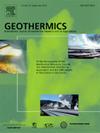Experimental investigation of heat migration in biochar-biopolymer-based thermal backfill material
IF 3.5
2区 工程技术
Q3 ENERGY & FUELS
引用次数: 0
Abstract
Thermal backfill is required to maintain the appropriate temperature around underground thermally activated structures (TAS) to increase their thermal insulation performance. Biochar is a porous carbon-rich material with exceptional thermal insulation properties and a high degree of carbon stability in soil, making it appropriate to use as a thermal backfill. Therefore, this research work investigates heat transfer in soil-biochar composite (SBC) and soil-biochar-biopolymer composite (SBPC) as thermal backfill material. The thermal insulation potential of SBC and SBPC was examined by fabricating a soil column with highly plastic silty soil, sugarcane bagasse biochar, and hardwood biochar. To prepare samples, the soil is amended with 5 % and 15 % biochar (w/w) and (0.5 %, w/w) biopolymer. For heat transfer investigation, a heater rod was inserted into the center of the soil column, with temperature sensors installed at various radial distances of 25, 50, 75, 100, and 125 mm from the heater rod. Further, the spatio-temporal variations were recorded for two cycles of heating and ambient cooling. The results revealed that both SBC and SBPC exhibit lower temperatures than virgin soil throughout all radial distances and time during the 1st and 2nd heating and ambient cooling cycles. The maximum temperature difference between virgin soil and SBC varies from 4 °C (at 125 mm) to 20 °C (at 25 mm), depending upon the distance from the heater rod. The finding of this study established the SBC and SBPC can be efficiently used as thermal backfill to mitigate heat transfer from TAS.
生物炭-生物聚合物基热回填材料热迁移的实验研究
为了提高地下热活化结构的保温性能,需要对地下热活化结构进行热回填。生物炭是一种多孔的富碳材料,具有优异的隔热性能和土壤中高度的碳稳定性,使其适合用作热回填。因此,本研究对土壤-生物炭复合材料(SBC)和土壤-生物炭-生物聚合物复合材料(SBPC)作为热回填材料的传热特性进行了研究。采用高塑性粉质土、蔗渣生物炭和硬木生物炭制备土柱,研究了SBC和SBPC的保温性能。为了制备样品,土壤中分别添加了5%和15%的生物炭(w/w)和(0.5%,w/w)的生物聚合物。为了进行传热研究,在土柱的中心插入一个加热棒,温度传感器安装在距离加热棒25、50、75、100和125毫米的不同径向距离上。此外,还记录了加热和环境冷却两个周期的时空变化。结果表明,在第一次和第二次加热和环境冷却循环中,SBC和SBPC在所有径向距离和时间上都表现出低于原生土的温度。根据与加热棒的距离不同,原始土和SBC的最大温差在4℃(125 mm时)~ 20℃(25 mm时)之间。研究结果表明,SBC和SBPC可以有效地作为热回填体来缓解TAS的热量传递。
本文章由计算机程序翻译,如有差异,请以英文原文为准。
求助全文
约1分钟内获得全文
求助全文
来源期刊

Geothermics
工程技术-地球科学综合
CiteScore
7.70
自引率
15.40%
发文量
237
审稿时长
4.5 months
期刊介绍:
Geothermics is an international journal devoted to the research and development of geothermal energy. The International Board of Editors of Geothermics, which comprises specialists in the various aspects of geothermal resources, exploration and development, guarantees the balanced, comprehensive view of scientific and technological developments in this promising energy field.
It promulgates the state of the art and science of geothermal energy, its exploration and exploitation through a regular exchange of information from all parts of the world. The journal publishes articles dealing with the theory, exploration techniques and all aspects of the utilization of geothermal resources. Geothermics serves as the scientific house, or exchange medium, through which the growing community of geothermal specialists can provide and receive information.
 求助内容:
求助内容: 应助结果提醒方式:
应助结果提醒方式:


